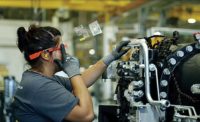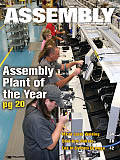
Traditionally, assembly plants contain offices and reception areas that are attached to the front of the factory. The plant floor is usually accessed by walking down a dull corridor and opening a nondescript door.
That’s not the case at the Philips Respironics plant in New Kensington, PA. A stunning, two-story atrium located near the entrance of the two-year-old facility more closely resembles something you’d find in a health club.
Visitors encounter a vast floor-to-ceiling window that overlooks the heart of the plant. “We don’t want to hide the production floor,” says Eric Kulikowski, senior director of North American operations at Philips Respironics. “The large window was intended to remind our guests and our employees that we are a manufacturing plant, not an office building.
“It is an architectural feature that creates a wonderful environment for events, meetings and lunch breaks,” adds Kulikowski. “It does impress first-time guests and allows them to see the look and feel of our shop floor as soon as they walk into the building.”
And, that’s not all that meets the eye. The entire plant floor is painted a distinctive shade of bright blue that resembles a swimming pool. “We’ve been thinking about posting ‘no diving’ signs,” chuckles Kulikowski. The unique color scheme was chosen by employees because it’s more energetic and motivating than the drab colors that are typically found on plant floors.
The 172,000-square-foot plant near Pittsburgh assembles electromechanical medical devices for the global sleep and respiratory market. Continuous positive airway pressure (CPAP) and bi-level positive airway pressure (BiPAP) devices provide a continuous stream of air pressure that’s used to treat obstructive sleep apnea.
“Any product, any quantity, any day” is the mantra of the Philips Respironics facility, which is the recipient of the 2011Assembly Plant of the Yearaward sponsored by ASSEMBLY magazine and The Boston Consulting Group Inc. (BCG). The high-volume, low-mix facility ships CPAP devices to more than 60 countries around the world.
Philips New Kensington was chosen for the 8th annualAssembly Plant of the Yearaward because it has creatively applied lean manufacturing principles and successfully implemented new production technology. The state-of-the-art facility was designed from the ground up with three things in mind: people, lean manufacturing and the environment.
Efficient manufacturing systems, such as raw material kanban, dock-to-stock material receipts, single-piece flow, digital work instructions, automation, world-class IT systems, flexible work teams, highly engaged employees, self-directed continuous improvement and mixed model assembly lines, are main tenants of Philips Respironics’ operations.
Since the $32 million plant opened in 2009, assembly errors have decreased more than 80 percent, while labor efficiency has improved by more than 35 percent. All processes and tools support building high-volume products in the most efficient and effective way possible.
“We are very impressed with the level of engagement and commitment on the part of all of Philips Respironics’ employees to building a culture of continuous improvement,” says Michael Zinser, partner in BCG’s Chicago office and a co-leader of its global manufacturing practice. “Many organizations struggle to achieve this level of success, but at Philips, the active participation of the management team in the development of its lean programs and the emphasis on employee engagement from the onset has been fundamental to its strong performance.
“Philips New Kensington has been able to create an environment where opportunity to improve on the key dimensions of quality, cost, delivery, safety and morale is never ending,” adds Zinser. “It shows in the progress they have made on their KPIs. And, we believe it will contribute to the organizations’ ability to maintain a competitive edge in the future.”
The 2011Assembly Plant of the Yearis also a greenfield facility that’s committed to sustainable manufacturing. For instance, 31 percent of the total building materials content, by value, was manufactured using recycled materials, while more than 55 percent of construction waste was recycled.
The plant was designed from the ground up for energy efficiency, utilizing natural light where possible, active light switching, motion sensors and an air circulation system located inside the building. The green facility was awarded LEED Gold certification in 2009. And, the parking lot has premium spots reserved for electric and hybrid vehicles.
“In addition, we encourage employees to stay green through our onsite recycling programs,” says Rachel Darcangelo, human resources manager. “We also encourage and support bicycling to work by providing bicycle storage racks.”
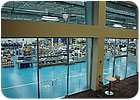
A Huge Market
Obstructive sleep apnea (OSA) is a common disorder that afflicts 20 million adults in the United States. In fact, more than 90 percent of NFL football players suffer from the disorder. People who have OSA stop breathing repeatedly during sleep because their airway collapses. Common sleep apnea symptoms include snoring, morning headaches and irritability.A recent study conducted by Global Industry Analysts Inc. predicts that the worldwide market for sleep apnea diagnostic and therapeutic devices will reach $6 billion by 2015. Demand is projected to grow throughout the rest of this decade, because approximately 100 million people worldwide are suspected of having OSA, of which 80 percent remain undiagnosed.
According to the American Sleep Apnea Association, pauses in breathing can occur 30 times or more per hour. When sleep is disrupted like that, the risk of developing cardiovascular disease and other serious health conditions may increase.
A CPAP device is the most commonly used therapy. It consists of a face mask that is attached by tubing to a small, portable unit that contains a base unit and a humidifier. Simple controls allow patients to select several different relative humidity settings.
A biomechanical engineer named Jerry McGinnis created the concept of the CPAP. While eating dinner at a restaurant near Pittsburgh, he sketched his idea on a napkin. In 1976, McGinnis started a company called Respironics Inc., which unveiled its first machine in 1985. Sales grew from $7 million in 1986 to $1 billion by 2006. Today, more than 5 million CPAP devices are in use around the world.
To meet growing demand, Respironics built a new factory in Murrysville, PA, in 1990. Today, that125,000-square-foot facility, which is located seven miles south of the New Kensington plant, specializes in low-volume, high-mix, highly complex items, such as life support ventilation systems and neonatal products. Its sister plant in New Kensington is highly automated, designed for swift material flow and heavily enabled by IT systems.
In 2008, Respironics was acquired by Royal Philips Electronics N.V. for $4.9 billion. Philips is a $33 billion multinational company based in Amsterdam. Its three main business units are healthcare, lighting and personal care.
“Within healthcare, the products assembled in New Kensington are one of the largest revenue product lines in all of Philips,” claims Kulikowski. “So, our contribution is significant. The respective markets are growing globally at very healthy levels and will continue to materially contribute to the growth of Philips healthcare.”
As a center of excellence for high-volume manufacturing, Philips Respironics is in the process of transferring several products to New Kensington from the award-winning Murrysville facility. “We have identified three product lines to meet our high-volume definition,” says Holly Muchenski, senior manager of electromechanical manufacturing. “These lines will now be able to leverage al of the systems and tools in place to positively impact high-volume products.”
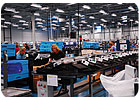
Employees Come First
Employees play a key role in the success of the 2011Assembly Plant of the Year. “[Our] plant is based upon a portfolio of progressive lean practices and a customer-focused culture,” says Kulikowski. “This combination provides Philips Respironics a strong competitive advantage within all of our markets.“But, successful organizations are defined by more than the numbers they produce or the metrics they track,” adds Kulikowski. “What makes the real difference is the engagement of great people and bringing the best out of them one can. At the New Kensington facility, our people are what define who we are today. And, the people side of our business our greatest reason for sustainable performance going forward.”
More than 120 employees across several shifts were engaged as subject matter experts, contributors and process owners when the plant was being designed several years ago. “Enable, empower and engage. These three words describe the culture that is in place at this facility,” says Kulikowski. “Associates from all departments and all levels are solving problems daily that relate to quality of products, quality of processes, plant safety and culture.
“Employee involvement teams drive the vast majority of improvement in these four areas of focus every day of the week,” Kulikowski points out. “At least 12 new improvement ideas are being implemented daily and no less than 15 employee teams are at work on solving problems and addressing opportunities at all times, around the clock.
Flexibility and quality are built into every process within Philips Respironics’ manufacturing operation. Employees are organized in a self-managed work team structure, allowing for maximum participation and authority at the lowest levels of the organization. In addition to operators, team members include quality assurance, material logistics, purchasing, accounting, human resources, product engineering and supplier quality assurance delegates.
One area that was greatly improved using this approach was material presentation and flow throughout the factory. “Move parts, not people” and “material presented in front of the operator” were guiding principles of the design of the manufacturing processes.
In a traditional lean assembly process, which Philips previously subscribed to, kanban bins are used to present material and signal for replenishment. In a high-volume assembly process with large to medium plastic components, the bins would be emptied very frequently and there would be a need to have many material handlers moving the bins back and forth from the warehouse to the production lines.
“We designed the material presentation and flow processes to deliver material by the pallet by a fork truck directly to the assembly line,” explains Kulikowski. “We [now] have material handlers that take components from the pallets and place them onto a conveyor track that constantly delivers the components to the assembly line. Not only does this process reduce cost by reducing the amount of touches and people in the process, but it also increases inventory accuracy since you are dramatically decreasing the inventory transactions made.”
The component delivery conveyor is affectionately called the NASCAR track by operators. It is an 85-foot-long, chain-driven conveyor with trays attached to it. Philips New Kensington uses three conveyors that each support two assembly lines. Kulikowski and his colleagues got the idea for the system by visiting a local pharmaceutical manufacturer.
The conveyor system contains component specific bins that are loaded by material handlers on the raw component end of the conveyor. Pallets of materials are brought to the line and load operators are responsible for presenting ready to use components to the appropriate bins.
“This eliminates assembly operators from performing non-value-added work, such as material preparation and detrashing,” says Kulikowski. “In addition, by bringing full pallets of material to the line, fewer material handlers are required to make fewer trips from the warehouse.”
The continuously running conveyor passes behind the assembly stations in front of the operators. Operators pick the components for their work content as the bins pass by. Each assembly line has the capability to build two products simultaneously. And, to reduce the risk of ergonomic-related injuries, all employees rotate positions every two hours.

Lean Lessons
Many advanced lean manufacturing principles are on display throughout the 2011Assembly Plant of the Year. For instance, the plant floor features pillars and a glass house for daily meetings.“Daily pillar meetings foster team discussion and employee engagement, while driving continuous improvement,” says Stefanie Lozito, continuous improvement leader. “This is an opportunity for the teams to briefly discuss their performance . . . reasons why they missed targets, and document and solve morale busters as a team. They celebrate ‘morale boosters’ as well. Because of the pillar meetings, associates are more engaged in all aspects of their work.
“The glass house is a place on the manufacturing floor, accessible to all and is a reflection of the department,” adds Lozito. “It contains bingo and trend charts that summarize the department’s performance, in addition to problem solving worksheets, morale buster lists and actions. All of this information drives discussion during problem solving teams, level meetings and Gemba walks.”
All employees at Philips New Kensington live and breath QCDSM, which measures and compels teams to improve their five key metrics: Quality, Cost, Delivery, Safety and Morale. All continuous improvement activities are tied to QCDSM in some way.
“It provides a balanced framework for improvement and communication and includes structured team reviews of progress at all levels in the organization,” says Kulikowski. “These reviews are called Level 1-4 meetings, where Level 1 includes and is led by the manufacturing associates and Level 4 is a weekly plant Gemba walk by the leadership team.
“QCDSM encourages participation and knowledge of area performance because the meetings are led by the associates and improvements are driven from all levels,” explains Kulikowski. “We borrowed the concept from Miller Brewing Co. The QCDSM pillar teams have a direct line of sight to plant performance, so they can see the impact of what they do.
“We use root cause analysis tools such as 5Why, and encourage problem solving teams at every level to address root cause and not the symptoms,” Kulikowski points out. “Every associate is trained in 5Why, 5S and our Quick and Easy Kaizen (QEK) methods, all of which drive improvements in both the manufacturing and business processes in our plants.”
Last year, Philips New Kensington conducted 38 5Whys and 11 5S events. In addition, it implemented more than 2,500 QEKs with 80 percent of employees participating and submitting ideas.
Those efforts have helped cut waste and streamline the functional layout of the plant. For instance, moving pallets of material directly to the assembly line resulted in fewer trips by fewer material handlers and improved delivery time of raw components.
Takt time has been reduced from 90 seconds to 30 seconds. This was accomplished through material presentation, balancing work content and flexing. The plant also invested in new production technology, such as embedded barcode scanners, screw presenters and DC electric screwdrivers to simplify operations.
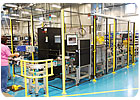
Advanced Production Tools
The 2011Assembly Plant of the Yearassembles three main product families: System One, BiPAP and Lifeline. The noninvasive ventilation products include advanced technology that can recognize patient needs and automatically make adjustments to pressure and humidity output.The typical CPAP device is 7 inches long, 5.5 inches wide, 4 inches tall and weighs 3 pounds. It is comprised to two main subassemblies: a base unit and a humidifier. The key components of the base unit are an enclosure, a blower unit and a control PCA board. The humidifier consists of an enclosure, a heating element and a tank assembly.
There are 28 steps in the CPAP production process. “In addition to the physical assembly of the components to build the device, the labeling, device history record and test results are all critical to the final product quality and satisfaction of our customers,” says David Zielinski, senior manager of equipment engineering. “We take great care to ensure that the devices are assembled correctly from the first assembly step to final packaging.”
Operators use DC electric torque monitored tools and DC electric clutch-type tools. Torque monitoring tools are used in cases where there is rotational and torque accuracy required and recorded.
“According to feedback from our customer base, from time to time they would receive a unit that was missing screws to hold the unit together,” says Zielinski. “To error proof this process, we implemented a smart torque driver. The torque driver lights up green after each screw is torqued correctly. Once all seven screws are applied, it lights up blue and the operator needs to push the button to start another unit.”
The standard work surface is a 16-by-36-inch table that’s equipped with an embedded scanner and a touchscreen flat panel industrial PC. Assemblers use the scanner to capture the barcode data present on every unit, including serial number and model number. They use this data to directly access the device history record for the unit being assembled.
This avoids having operators handle a tethered, hand scanner and flipping the unit over to access the labels. The flat panel computers are used to display the device data, as well as display the electronic assembly instructions.
“A device history record is required for each unit we build,” says Kulikowski.”This is a document that compiles all the critical information during the assembly of that unit. Component lot numbers, test data, serial numbers, assembly and quality signatures are all example information that is included in a unit device history record.
“We significantly reduced cost by developing and implementing electronic device history records,” adds Kulikowski. “Essentially, the factory is paperless.”
Each serial number is generated at the beginning of the assembly process in an ERP system. At each assembly and test station, the unit serial number is scanned in and information is added to the device history record compiled in the system. This system reduced cost by eliminating the paper, filing and storage of each device history record.
Philips New Kensington implements plant-floor technology based on a “creativity before capital” approach. It operates an in-house equipment development lab.
“Production support, managing change and minimal downtime due to equipment-related issues are the biggest advantages of developing equipment in house,” claims Zielinski. “In addition, we have the expertise and knowledge of our devices and interfaces. In our regulated environment, we have the control of data, test records and compliance data in house and managed in our SAP system. The functionality built into our test equipment designs is critical to the success of our paperless device history record system.
“The support, change management and integration of this functionality is an in-house competency,” adds Zielinski. “In terms of cost, developing in house is a major advantage. With the technical knowledge, and expertise across software, electrical and mechanical engineering disciplines, we can often realize an ROI of 12 months or less on major equipment initiatives by developing equipment ourselves.”
Zielinski and his colleagues recently developed an automated testing platform. The in-house design performs all aspects of functional testing, calibration and vision inspection. The test rack can handle 48 units at a time.
Through the use of an articulated robot, screw presence detection and user interface manipulation is performed. The mini robot is used to manipulate knobs and buttons on the unit under test.
Vision inspection is used to identify devices, verify assembly operations and match text to barcode labels. In addition, the system manages the test record directly through the use of a custom designed interface between the test software and SAP system. This eliminates all operator interaction. The first system moved to the production floor in April, and the plant is in the process of adding five more systems.
Each device must also undergo an operation to install firmware. In the past, it was installed by PC board suppliers. “By moving this operation into our manufacturing operations, we have total control of the flashing and firmware, reduce the cost of rework by being able to manage this ourselves, and improved agility in firmware change implementation,” says Kulikowski. A

About the Award
The Assembly Plant of the Year award was initiated in 2004 to showcase world-class production facilities in America, and the people, products and processes that make them successful. All manufacturers that assemble products in the United States are invited to nominate their plants. Unlike many other awards, there is no entry fee.
The Assembly Plant of the Year award is sponsored by ASSEMBLY Magazine and The Boston Consulting Group Inc. (BCG), a global management consulting firm that is the world’s leading advisor on business strategy.
The goal of the Assembly Plant of the Year award is to identify a state-of-the-art facility that has applied world-class processes to reduce production cost, increase productivity, shorten time to market or improve product quality.
An official nomination form appeared on the magazine’s Web site earlier this year. Nominations were received from a diverse group of manufacturers that reflect the magazine’s demographics.
All nominees were evaluated by ASSEMBLY’s editorial staff and by BCG’s operations practice, based on criteria such as:
- Have assembly processes been improved through the use of new technology?
- Has the plant improved its performance by making more effective use of existing technology?
- Has the plant taken steps to reduce production costs?
- Have new or improved assembly processes resulted in increased productivity?
- Has the plant used assembly improvements to reduce time to market?
- Has the plant boosted bottom-line profits and competitive advantage?
- Did operators play a role in the successful implementation of new assembly strategies?
- Has a product been effectively designed for efficient assembly?
- Has the plant attempted to protect the environment and conserve natural resources?
As winner of the 8th annual Assembly Plant of the Year competition, Philips’ New Kensington, PA, facility received an engraved crystal award and a commemorative banner during a special presentation at the plant.
Previous recipients of the Assembly Plant of the Year award were Eaton Corp. (Lincoln, IL); Batesville Casket Co. (Manchester, TN); IBM Corp. (Poughkeepsie, NY); Schneider Electric/Square D (Lexington, KY); Lear Corp. (Montgomery, AL); Xerox Corp. (Webster, NY); and Kenworth Truck Co. (Renton, WA).
Learn more about the 2011 Assembly Plant of the Year by clicking www.assemblymag.com and searching for these articles:
- A Classy Way to Honor Veterans.
- Assembly Radio: Interview With Eric Kulikowski.
- Behind the Scenes at Philips New Kensington.
- Continuous Improvement Is a Way of Life at Philips Respironics.
- Local Consortium Promotes Benchmarking.
- Recycling Program Propels Green Manufacturing.
- Staying Fit in New Kensington.
- Warehouse Improvements Streamline Delivery.

